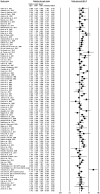Understanding patients' adherence-related beliefs about medicines prescribed for long-term conditions: a meta-analytic review of the Necessity-Concerns Framework
- PMID: 24312488
- PMCID: PMC3846635
- DOI: 10.1371/journal.pone.0080633
Understanding patients' adherence-related beliefs about medicines prescribed for long-term conditions: a meta-analytic review of the Necessity-Concerns Framework
Abstract
Background: Patients' beliefs about treatment influence treatment engagement and adherence. The Necessity-Concerns Framework postulates that adherence is influenced by implicit judgements of personal need for the treatment (necessity beliefs) and concerns about the potential adverse consequences of taking it.
Objective: To assess the utility of the NCF in explaining nonadherence to prescribed medicines.
Data sources: We searched EMBASE, Medline, PsycInfo, CDSR/DARE/CCT and CINAHL from January 1999 to April 2013 and handsearched reference sections from relevant articles.
Study eligibility criteria: Studies using the Beliefs about Medicines Questionnaire (BMQ) to examine perceptions of personal necessity for medication and concerns about potential adverse effects, in relation to a measure of adherence to medication.
Participants: Patients with long-term conditions.
Study appraisal and synthesis methods: Systematic review and meta-analysis of methodological quality was assessed by two independent reviewers. We pooled odds ratios for adherence using random effects models.
Results: We identified 3777 studies, of which 94 (N = 25,072) fulfilled the inclusion criteria. Across studies, higher adherence was associated with stronger perceptions of necessity of treatment, OR = 1.742, 95% CI [1.569, 1.934], p<0.0001, and fewer Concerns about treatment, OR = 0.504, 95% CI: [0.450, 0.564], p<0.0001. These relationships remained significant when data were stratified by study size, the country in which the research was conducted and the type of adherence measure used.
Limitations: Few prospective longitudinal studies using objective adherence measures were identified.
Conclusions: The Necessity-Concerns Framework is a useful conceptual model for understanding patients' perspectives on prescribed medicines. Taking account of patients' necessity beliefs and concerns could enhance the quality of prescribing by helping clinicians to engage patients in treatment decisions and support optimal adherence to appropriate prescriptions.
Conflict of interest statement
Figures





References
-
- National Institute for Health and Clinical Excellence (2009) Medicines adherence: involving patients in decisions about prescribed medicines and supporting adherence CG76. London: National Institute for Health and Clinical Excellence. - PubMed
-
- World Health Organisation (2003) Adherence to Long-term Therapies: Evidence for Action. Geneva: World Health Organisation.
-
- Horne R, Weinman J, Barber N, Elliott RA, Morgan M (2006) Concordance, Adherence and Compliance in Medicine Taking: A conceptual map and research priorities. London: National Institute for Health Research (NIHR) Service Delivery and Organisation (SDO) Programme. Available: http://www.sdo.lshtm.ac.uk/sdo762004.html. Accessed October 17th 2013.
-
- Haynes RB, Yao X, Degani A, Kripalani S, Garg A, et al... (2005) Interventions to enhance medication adherence. Cochrane Database Syst Rev: CD000011. - PubMed
Publication types
MeSH terms
Grants and funding
LinkOut - more resources
Full Text Sources
Other Literature Sources
Miscellaneous

